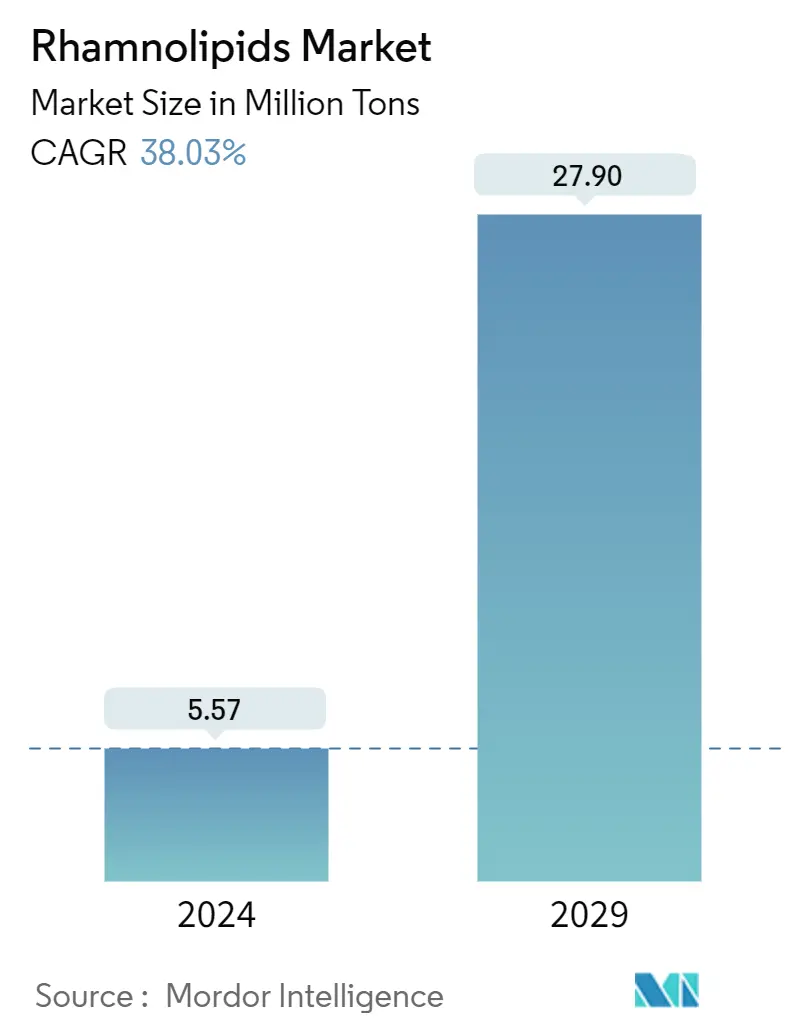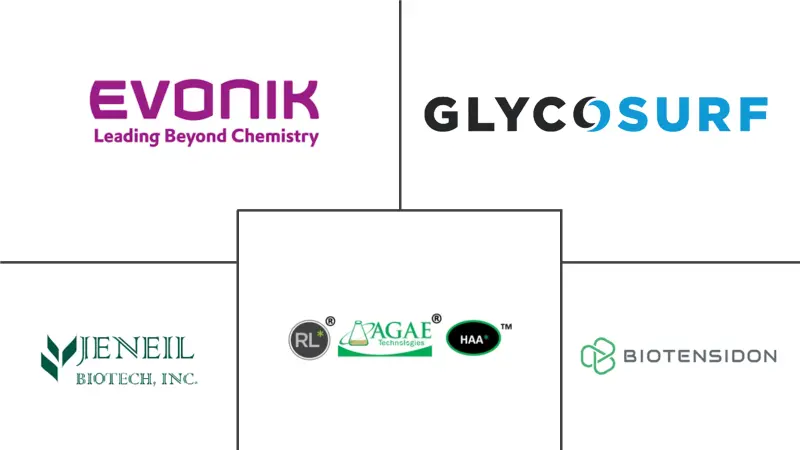Market Size of Rhamnolipids Industry

| Study Period | 2019-2029 |
| Base Year For Estimation | 2023 |
| CAGR (2024 - 2029) | 38.03 % |
| Fastest Growing Market | Europe |
| Largest Market | Europe |
| Market Concentration | Medium |
Major Players
*Disclaimer: Major Players sorted in no particular order |
Rhamnolipids Market Analysis
The Rhamnolipids Market size is estimated at 5.57 Million tons in 2024, and is expected to reach 27.90 Million tons by 2029, growing at a CAGR of 38.03% during the forecast period (2024-2029).
- The COVID-19 outbreak resulted in a global lockdown, a breakdown in supply chains and manufacturing activities, and production halts, all of which had a detrimental effect on the market in 2020. However, things started to get better in 2021, which allowed the market to resume its upward trend for the remainder of the projected period.
- The major factor driving the market studied is the growing demand for rhamnolipids from eco-friendly surfactants. Moreover, the increasing demand for personal care products is also expected to fuel the market demand.
- On the flip side, limitations in the production of rhamnolipids on an industrial scale have hindered the growth of the market.
- The upcoming research in the applications of rhamnolipids is forecasted to offer various opportunities for the growth of the market over the forecast period.
- Europe region represents the largest market and is also expected to be the fastest-growing market over the forecast period owing to the increasing consumption from countries such as Germany, the United Kingdom, and France.
Rhamnolipids Industry Segmentation
Rhamnolipids (RL) are members of the glycolipid biosurfactant family. The amphiphilic properties of rhamnolipids allow them to reduce the interfacial tension between two substances that normally would not mix.
The Rhamnolipids market is segmented by product type, application, and geography. By type, the market is segmented into Mono-Rhamnolipids and Di-Rhamnolipids. By application, the market is segmented into surfactants, cosmetics, agriculture, food, pharmaceuticals, and other applications. The report also covers the market size and forecasts for the rhamnolipids market across major regions (Asia-Pacific, North America, Europe, South America, and Middle-East and Africa). For each segment, the market sizing and forecasts have been done based on volume.
| Type | |
| Mono-Rhamnolipids | |
| Di-Rhamnolipids |
| Application | |
| Surfactants | |
| Cosmetics | |
| Agriculture | |
| Food | |
| Pharmaceutical | |
| Other Applications |
| Geography | |
| Asia-Pacific | |
| North America | |
| Europe | |
| South America | |
| Middle-East and Africa |
Rhamnolipids Market Size Summary
The rhamnolipids market is poised for significant growth, driven by the increasing demand for eco-friendly surfactants and personal care products. Rhamnolipids, known for their biodegradability and environmental benefits, are gaining traction as a sustainable alternative to synthetic surfactants. This shift is particularly evident in the detergent and cleaning product industries, where there is a growing need for environmentally sound ingredients. Despite challenges in industrial-scale production, ongoing research and development are expected to unlock new applications and opportunities for rhamnolipids, further propelling market expansion. The European region, led by countries like Germany, the United Kingdom, and France, is at the forefront of this growth, with significant investments in production technologies and product development.
The market landscape is characterized by a partial consolidation, with key players such as Evonik Industries AG, Jeneil Biotech, Stepan Company, AGAE Technologies LLC, and Biotensidon GmbH leading the charge. These companies are actively investing in innovative production methods and facilities to enhance rhamnolipid yields and reduce costs, thereby strengthening their market positions. Notable developments include AGAE Technologies' advancements in fermentation techniques and Evonik's investment in a new production plant for bio-based rhamnolipids. As the demand for sustainable and biodegradable products continues to rise, the rhamnolipids market is expected to experience robust growth, with Europe maintaining its dominance throughout the forecast period.
Rhamnolipids Market Size - Table of Contents
-
1. MARKET DYNAMICS
-
1.1 Drivers
-
1.1.1 Emergence of Eco-friendly Surfactant
-
1.1.2 Increasing Demand For Personal Care Products
-
-
1.2 Restraints
-
1.2.1 Limitation in the Production of Rhamnolipids on an Industrial Scale
-
-
1.3 Industry Value Chain Analysis
-
1.4 Porter's Five Forces Analysis
-
1.4.1 Threat of New Entrants
-
1.4.2 Bargaining Power of Buyers
-
1.4.3 Bargaining Power of Suppliers
-
1.4.4 Threat of Substitute Products
-
1.4.5 Degree of Competition
-
-
-
2. MARKET SEGMENTATION (Market Size in Volume)
-
2.1 Type
-
2.1.1 Mono-Rhamnolipids
-
2.1.2 Di-Rhamnolipids
-
-
2.2 Application
-
2.2.1 Surfactants
-
2.2.2 Cosmetics
-
2.2.3 Agriculture
-
2.2.4 Food
-
2.2.5 Pharmaceutical
-
2.2.6 Other Applications
-
-
2.3 Geography
-
2.3.1 Asia-Pacific
-
2.3.2 North America
-
2.3.3 Europe
-
2.3.4 South America
-
2.3.5 Middle-East and Africa
-
-
Rhamnolipids Market Size FAQs
How big is the Rhamnolipids Market?
The Rhamnolipids Market size is expected to reach 5.57 million tons in 2024 and grow at a CAGR of 38.03% to reach 27.90 million tons by 2029.
What is the current Rhamnolipids Market size?
In 2024, the Rhamnolipids Market size is expected to reach 5.57 million tons.

